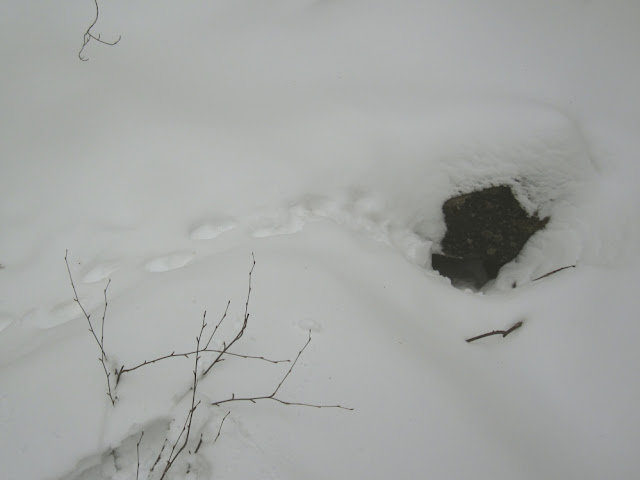Glen sees this guy quite often, saying that he comes out to help him when he's working on the wood pile. So he's named him Pete. Sometimes he finds Pete lounging on the walkway where the stone has absorbed the heat of the sun.
 |
| A nice place for an afternoon nap. Photo by Glen Powell. |
Other times he's curled up, napping beside the foundation, enjoying the extra warmth emanating from the ground and the house.
 |
| Curled up under the deck. Photo by Glen Powell. |
Or perhaps he's just hanging around, lapping up some snow-melt from a sunny, southern-exposure snow field.
 |
| Completely vunlerable, yet unconcerned. Photo by Glen Powell. |
He reminded me that I hadn't been out to Porcupine Ridge this winter to check on our local porcupines, so I took a snowshoe out to see if they're still around. It was right after a fresh snowfall, so I knew any tracks would have occured just the night before. (That's the tradeoff with new snow - you know tracks are very recent, but there also aren't many because they've all been obliterated.) Sure enough, I found plenty of tracks just from last night leading into (or out of) various little caves and crevices among the boulder field on the ledge.
 |
| Fresh tracks reveal a porcupine hideout |
I enjoy finding these little porky hideouts, but I always make plenty of noise as I approach. The only time I've had a close encounter with a porcupine was on a winter hike in Homestead Forest in Ashland, and I wasn't even looking for animals. I was just walking along the trail, approaching Devil's Den, when out one popped from under a rock right beside the trail.
 |
| A well worn porcupine path on the trail in Homestead Forest |
He was as startled as I was, but he just turned around slowly and went back to his hideout. If you haven't been there, Homestead Forest is a really neat area (owned and protected by the Lakes Region Conservation Trust) with 3.5 miles of trails, old homesteads, nice views, and Devil's Den - a giant boulder field.
You can find directions, a trail map, and pictures by clicking here. But if you go, watch out for Pete's nephew!



































